Glaciers accumulate significant amounts of fallout radionuclides from nuclear accidents and weapons testing – sometimes in the highest radioactive concentrations ever found outside of nuclear exclusion zones and test sites. Michael Allen digs into the depths of this unexpected issue and the associated risks as glaciers melt
Think of glaciers and images of vast, pristine sheets of ice, blanketing swathes of the Arctic and the Antarctic come to mind. While it’s true that 99% of glacial ice is restrained to the polar regions of our planet, glaciers are also found in mountain ranges on almost every continent, covering nearly 10% of the Earth’s land surface. Glacial ice is also the largest reservoir of fresh water on our planet – holding almost 69% of the world’s fresh water.
Despite appearing as silvery untouched rivers of ice in images, glaciers contain many organic deposits, such as dust and microbes. But researchers are finding they also encompass a worrying amount of toxic nuclear materials, and we are only now beginning to understand the risks posed as glaciers melt.
“For some of these glaciers that have been assessed, particularly the ones in the European Alps and other parts of Europe, the concentrations of some of these fallout radionuclides are as high as we’ve recorded them inside disaster zones like Chernobyl or the Fukushima area in Japan,” explains Philip Owens, an environmental scientist at the University of Northern British Columbia, in Canada.
Dust, dirt, microbes
Up close, glaciers are not perfectly white. They are often grey and dirty looking, even black in places, thanks to deposits. Known as cryoconite, this dark, fine sediment that forms on glacial surfaces is made up of dust, dirt and soot, as well as small rock and mineral particles. It originates from a variety of places, including the local surroundings such as weathered rocks and exposed ground near the glacier – but also from faraway sources like deserts and arid land, wildfires and combustion engines.
These materials are carried onto glaciers through various processes such as wind, rain, atmospheric circulations, and anthropogenic and animal activities. Because this cryoconite is dark in colour it heats up in the Sun and melts the ice, creating water-filled depressions. These holes then become traps for more material, causing larger collections of cryoconite to form.
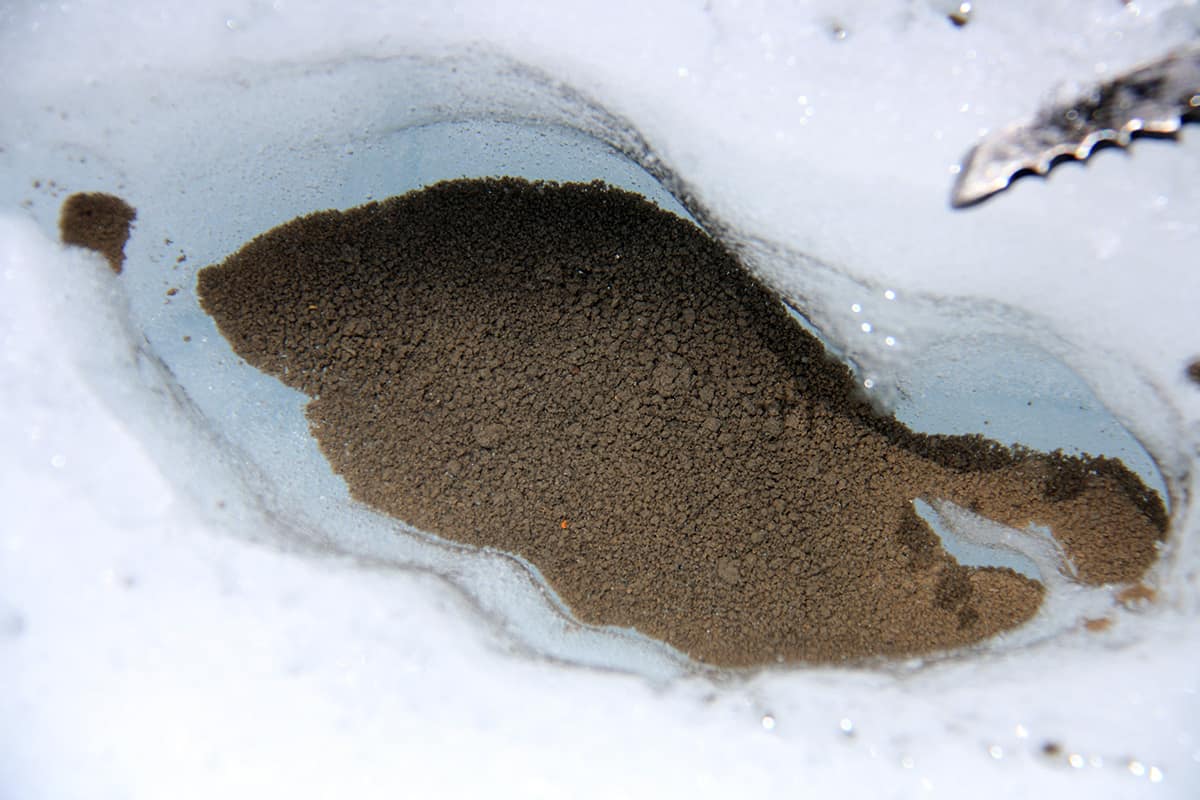
Cryoconite is also full of organic materials such as algae, fungi, bacteria and other microbes. As these collect, grow and multiply on the sediment, they start to form a considerable part of the cryoconite mass. The organic matter also produces sticky biofilms, which help the microbes to stick to the sediment and each other, and form communities, helping collections of cryoconite to further grow.
But cryoconite is not just rocks, dust, dirt and microbes. Research has shown that it is also full of many different anthropogenic contaminants, including heavy metals, pesticides, microplastics and antibiotics. Like the more natural components, these too are trapped by the watery depressions and sticky biofilms, binding to the dust and minerals in the sediment.
Far-reaching radioactive fallout
In recent years it has become clear that cryoconite is often full of another rather unexpected contaminant – nuclear material in the form of “fallout radionuclides” (FRNs). Tests found that the concentrations of these artificial radionuclides greatly exceed those in other terrestrial environments. Indeed, some of these sediments are the most radioactive ever found outside of nuclear exclusion zones and test sites.
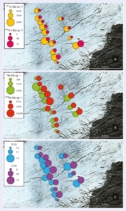
It has been known for a while that the surfaces of glaciers can have unusually high levels of radioactivity. In recent years scientists have been exploring the issue in more detail. According to glaciologist Caroline Clason from Durham University, in the UK, the concentration of radioactivity seen in cryoconite is sometimes “two or even three orders of magnitude higher than we would find in other types of environmental matrices, like sediments and soils, lichens and mosses that we find in different parts of the world”.
In 2017 Clason and colleagues discovered that levels of fallout radionuclides in cryoconite from the Isfallsglaciären glacier in Arctic Sweden were up to 100 times higher than in material collected in the valley around the glacier (figure 1). Concentrations of the radioactive isotope caesium-137 (137Cs) were as high as 4500 becquerels per kilogram (Bq/kg), with average levels of around 3000 Bq/kg (TC 15 5151). “It’s quite incredible how much [radioactivity] the material on the glacier surface has managed to accumulate,” says Clason. “Much more than we see in the rest of the environment in the same location.”
In 2018 cryoconite on a Norwegian glacier was found to be even more radioactive (Sci. Tot. Env. 814 152656). Samples, collected by a team led by Edyta Łokas, an earth scientist at the Institute of Nuclear Physics of the Polish Academy of Sciences, from 12 cryoconite holes on the Blåisen glacier revealed concentrations of 137Cs as high as 25,000 Bq/kg, with an average level of around 18,000 Bq/kg. Levels of 137Cs in soils and sediments are usually between 0.5 and 600 Bq/kg (Sci. Rep. 7 9623).
Chernobyl’s contamination
The artificial radionuclides 137Cs and caesium-134 (134Cs) are fission products produced by the splitting of uranium-235 in nuclear power reactors and some nuclear weapons. Most of the caesium isotopes on the Norwegian and Swedish glaciers originate from the Chernobyl nuclear accident, but there is also fallout from the hundreds of atmospheric nuclear tests conducted in the mid-20th century.
Infamous as the worst disaster in the history of nuclear power generation, the Chernobyl incident took place on 26 April 1986 during a low-power test of the Number Four reactor at the Chernobyl nuclear power plant, which was then in the Soviet Union. The test caused an explosion and fire that destroyed the reactor building, and the catastrophic incident released a significant amount of radioactive material, including isotopes of plutonium, iodine, strontium and caesium. Most of this fell in the immediate vicinity of the nuclear power plant and large areas of what is now Ukraine, Belarus and Russia, but atmospheric circulations, as well as wind and storm patterns, also scattered it over much of the northern hemisphere.
Weather patterns dumped a substantial amount of the radioactive fallout from Chernobyl in Scandinavia. Norway is estimated to have received around 6% of the 137Cs and 134Cs released from the nuclear power plant. The isotopes were carried to the country by a south-easterly wind and deposited during rainfall in the days following the nuclear disaster.

Glimpsing Chernobyl’s hidden hotspots
The caesium then entered the food chain, as it was taken up by plants, lichens and fungi, which were eaten by grazing animals such as reindeer and sheep. In the years following the disaster large amounts of meat, milk and cheese from reindeer and sheep in Norway and Sweden had caesium-isotope concentrations that massively exceeded limits set by the authorities. These foods are still regularly tested.
There was also significant fallout from Chernobyl in the Austrian Alps, with heavy rainfall in the days following the disaster leading to very high levels of contamination in some areas. A 2009 survey of the Hallstätter and Schladminger glaciers in northern Austria found concentrations of 137Cs in cryoconite ranging from 1700 Bq/kg to 140,000 Bq/kg (J. Env. Rad. 100 590).
Wind, rain, fire and more
There appear to be several reasons why cryoconite accumulates radionuclides and becomes so radioactive. Radioactive material is transported through the atmosphere by winds and global circulation patterns. It is then washed out of the atmosphere by precipitation, which is known to be particularly effective at collecting particulate matter and bringing it down to the ground. Furthermore, levels of rain, snowfall and fog tend to be high in the mountain and polar regions that host glaciers.
A lot of dry material, from phenomena such as forest fires and dust storms, also gets dumped in glacial environments. This dust, soot and similar material travels via atmospheric circulation, but as it does so it starts to bind together and scavenge other material from the atmosphere – including pollutants such as radionuclides – until it becomes too heavy and falls to the ground.
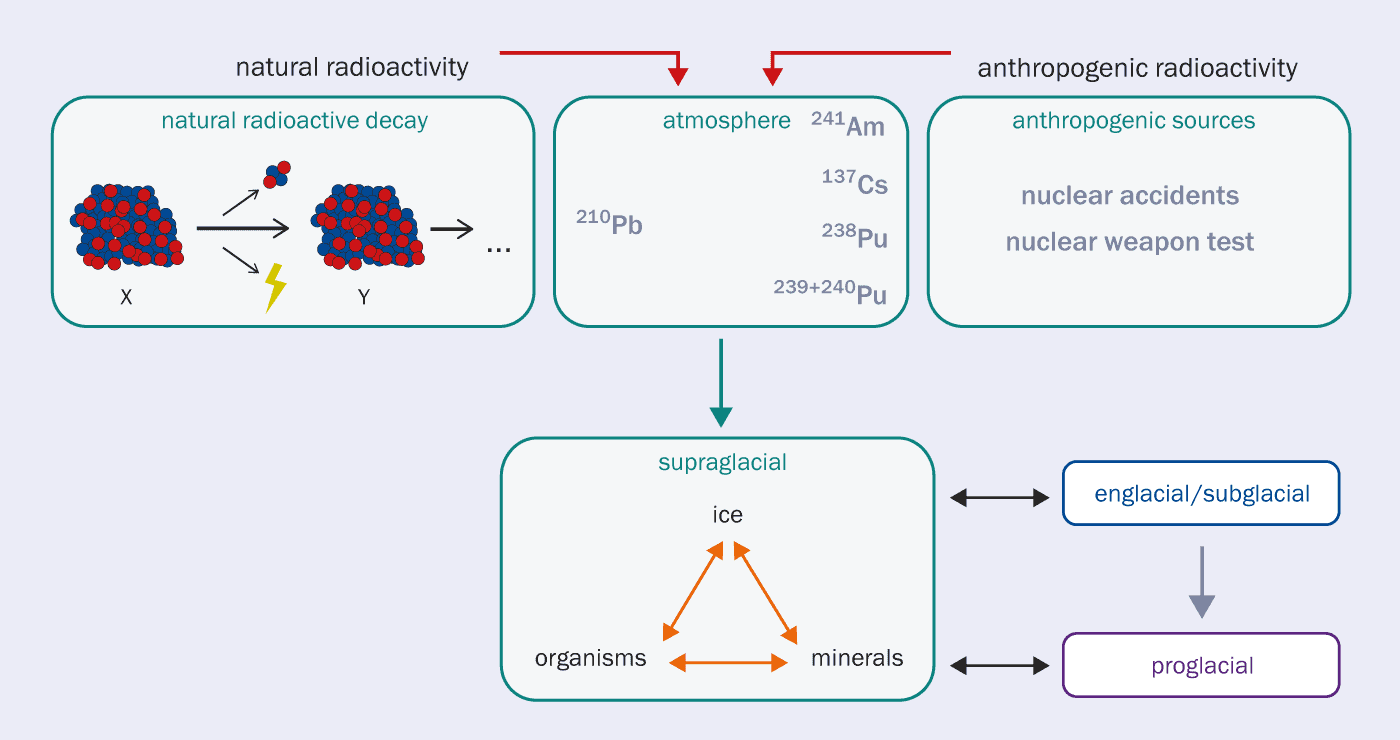
Once radionuclides and other contaminants are in the glacial environment, they are shifted around by hydrological processes. In warmer parts of the year, snow pack and ice in a glacial catchment melt, along with parts of the glacier itself. This melt water flows onto and over the glacier, taking contaminants like the radionuclides that were stored in the snow and ice with it. As the water flows through channels and holes across the glacier, it is filtered by cryoconite sitting in these depressions, which is full of materials including silts and clay that are known to bind elements such as radionuclides, metals and other anthropogenic particles (figure 2).
Organic scavengers
The biological component of cryoconite also seems to enhance its ability to collect and accumulate radionuclides. Indeed, Łokas explains that for cryoconite with a high proportion of organic material – such as algae, fungi and bacteria – the concentration of radionuclides is much higher.
The cryoconite on the Blåisen glacier in Norway that had particularly high levels of radioactivity also had a high organic content. While studies of other glaciers have found cryoconite that was between 5% and 15% biological material, the sediments from Blåisen were around 30% organic matter. The researchers say this could be part of the reason for its high concentrations of radionuclides.
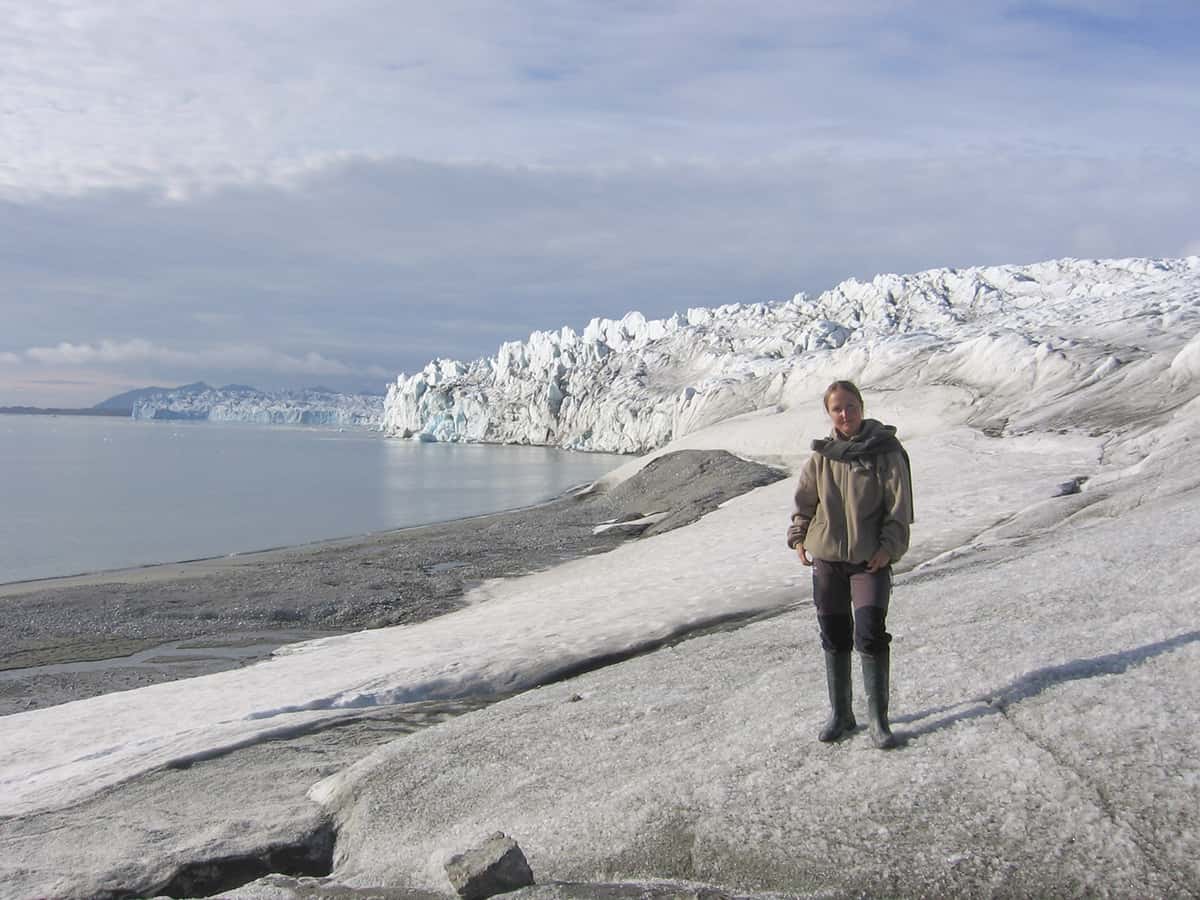
Łokas says that the ability of cryoconite to hold and concentrate radionuclides seems to be “related to metal binding properties of extracellular substances that are excreted by micro-organisms”. These sticky biofilms immobilize metals, and other materials that can be toxic, to prevent them from entering the cells of the micro-organisms, she explains.
This link between organic matter and fallout radionuclides has also been spotted elsewhere. When Owens analysed cryoconite samples from the Castle Creek glacier in British Columbia, Canada, he found a significant positive relationship between the concentration of radionuclides in samples and the percentage of organic material (Sci. Rep. 9 12531). The more biological material, the more radioactive material.

Ten years after Fukushima: could new fuels make nuclear power safer?
Owens explains that fallout radionuclides are everywhere. What’s happening on glaciers, he says, is that they are “being focused into these really small locations on the glacier surface”. There are ways that both the materials that make up the sediment and the extracellular substances excreted by the micro-organisms that live in it, can bind contaminants. This all makes the cryoconite a highly efficient scavenging agent, and over time radionuclides that have fallen all over the glacial catchment become concentrated in it.
Varying sources and concentrations
Although it tends to be the most concentrated, 137Cs is not the only radionuclide found in cryoconite. High concentrations of other radioactive materials, such as americium-241 (241Am), bismuth-207 (207Bi) and plutonium (Pu) isotopes, have also been detected. These are linked to the global fallout of radionuclides from atmospheric nuclear weapons tests rather than nuclear-power disasters.
This mix of inputs, along with global atmospheric circulation and weather patterns, means that sources and concentrations of radioisotopes on glaciers vary across the planet. For instance, Owens says that while levels of radionuclides are high in cryoconites in Canada they are mainly from nuclear bomb tests, as it is a long way from Chernobyl.
Łokas is currently analysing details of radioactivity in cryoconites from various sites around the world, including in the Arctic, Iceland, the European Alps, South America, the Caucasus Mountains, British Columbia and Antarctica. Glaciologists from many countries, including Owens and Clason, have donated, collected and tested samples for this work.
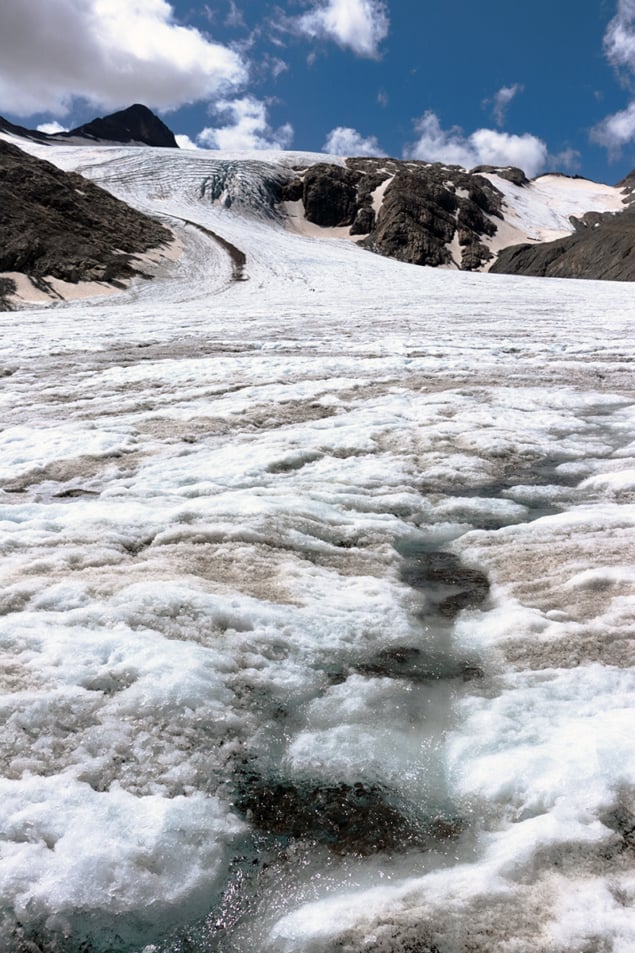
Tests have found that radioactivity is particularly high in the Alps and Scandinavia, while Łokas says the lowest levels found so far have been on glaciers in Iceland and Greenland. No signal from Chernobyl was identified in these areas, just the global fallout from weapons tests, Łokas adds.
The work has also identified some interesting radionuclide signals. There are higher proportions of 238Pu, 239Pu and 240Pu in cryoconites from the southern hemisphere than the northern hemisphere, Łokas says. This is due to the failure of a satellite carrying a SNAP-9A radiothermal generator in 1964. The satellite disintegrated, releasing around a kilogram of 238Pu into the atmosphere, mainly over the southern hemisphere.
There is also a spike in 238Pu isotopes from samples of the Exploradores glacier in Chilean Patagonia. This is likely linked to the failed Russian Mars probe that broke up in the atmosphere over South America in 1996, Łokas says. It was carrying around 200 g of 238Pu pellets and, while their exact fate is unknown, they are thought to have fallen somewhere over Chile and Bolivia.
Cause of concern?
It is as yet unclear how worried we need to be about this concentration of radioactive material on glaciers. There is no certainty over whether it poses an environmental risk on a large scale, or whether it is a localized issue on the glaciers, Clason says. “I certainly wouldn’t want to go and eat the material on the ice surface; it’s really quite radioactive in comparison to other environmental sediments,” she adds. “But the extent to which that’s a problem once you are outside of that immediate glacial catchment, we just don’t know.”
When the sediment is sitting on the glacier, it is unlikely to be an issue for the ecosystem and human health. But as glaciers melt and retreat more and more of that legacy material stored on the ice gets released
There are reasons to be concerned. Radioactive materials have well-documented negative impacts on health. Glaciers also store vast amounts of fresh water, with billions of people around the world using the melt water for agriculture and drinking water. As the climate warms, glaciers are also retreating, which could potentially release stored contaminants and sediments in high concentrations.
“With all the glacial melt, this cryoconite material is coming into a lot more contact with glacial melt water. It’s now beginning to be exposed and can be delivered to the downstream ecosystem,” Owens explains. When the sediment is sitting on the glacier, he says, it is unlikely to be an issue for the ecosystem and human health. But as glaciers melt and retreat more and more of that legacy material stored on the ice gets released.
It is also not clear exactly how much radioactivity there might be in a glacial system, Clason adds. “In addition to direct atmospheric deposition of radionuclides, a lot of the radioactivity we see in cryoconite is likely being melted out of old snow and ice that was deposited many years ago,” Clason explains. “The ice itself has an inventory of radioactivity that isn’t well understood.”

Chernobyl’s hidden legacy
Once it flows into rivers, the radioactive material is likely to be diluted, Owens says, “but we don’t know,” he cautions. Clason agrees. “While the concentrations are high where we sample, in the grand scheme of things, once all that material has been washed off or the glacier melts and deposits it in the environment, it might be diluted to the extent that it’s not above the concentrations you see in the environment otherwise,” she says. “So that’s what we need to figure out next.”
In the future, Clason hopes to carry out more detailed analysis of the amount of cryoconite on glacial surfaces, using techniques such as high-resolution drone imagery. This would allow researchers to estimate how much radioactivity there might be on a glacier. Mapping the cryoconite on the surface like this, and then combining the information with glacier melt models, could help us understand how the sediments and the contaminants they contain might be released in the future.
- SEO Powered Content & PR Distribution. Get Amplified Today.
- PlatoAiStream. Web3 Data Intelligence. Knowledge Amplified. Access Here.
- Minting the Future w Adryenn Ashley. Access Here.
- Buy and Sell Shares in PRE-IPO Companies with PREIPO®. Access Here.
- Source: https://physicsworld.com/a/trapped-in-ice-the-surprisingly-high-levels-of-artificial-radioactive-isotopes-found-in-glaciers/



